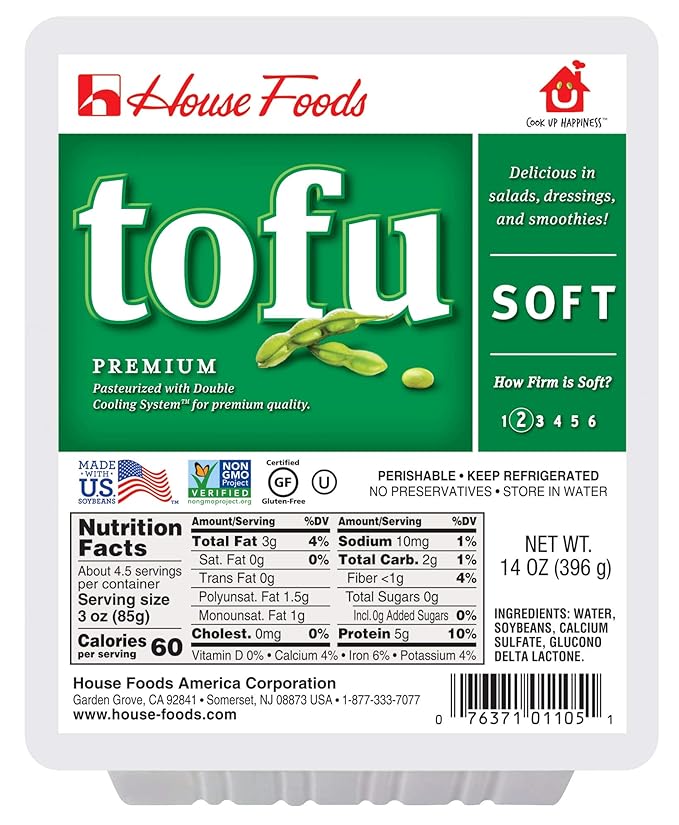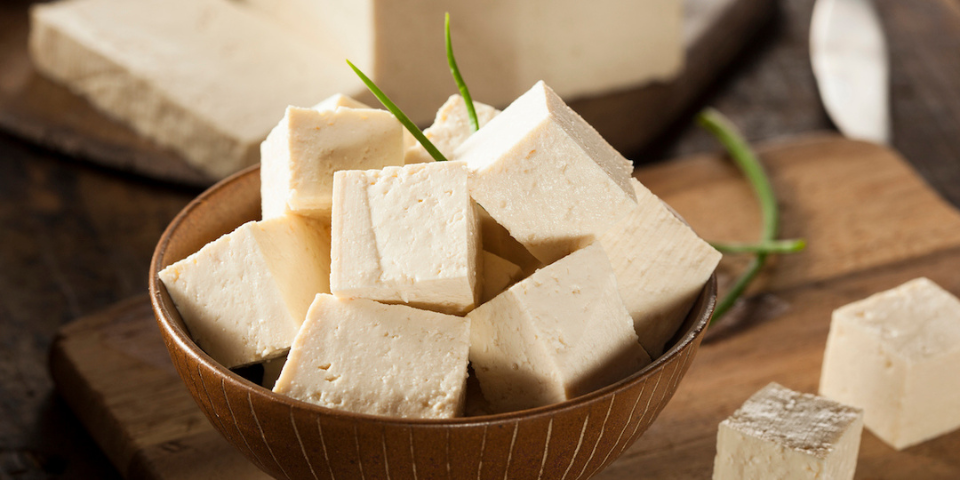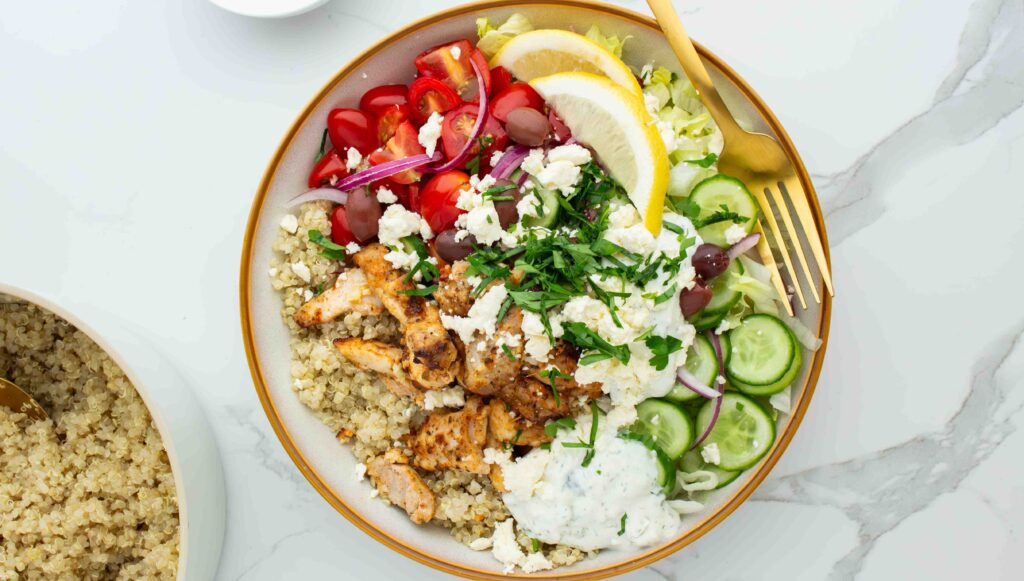Unless you’re a diehard vegan, you probably don’t think of tofu as the most appetizing food. But this seemingly basic block of soy is full of potential, and there are so many different types of tofu to work with!
In just a few simple steps, you can create a super tasty source of plant-based protein that’s crispy or creamy, spicy or smoky, sweet or savory — you name it.
All it takes is selecting the right kind of tofu and preparing it correctly. Using silken tofu in a stir-fry will lead to a soggy mess, while trying to blend extra-firm tofu into your smoothie will likely result in a chunky consistency.
Avoid kitchen disasters by following this guide to cooking with different types of tofu.
What Is Tofu?
Tofu is made from soybeans and water (essentially, soy milk) with added coagulant, most often nigari (liquid that remains after salt is removed from seawater). It comes in two different consistencies: “block” or “regular” tofu, and silken tofu. The difference is that block tofu is pressed, so it has less water, and therefore generally retains its shape better.
“Tofu is affordable, versatile, nutritious, and delicious. It can be used in both savory and sweet applications and generally takes on the flavor of whatever you cook it with,” says vegan chef Lauren Kretzer.
Types of Tofu
Here’s a breakdown of the different tofu types you’ll encounter, and the best ways to use each one.
Super-firm tofu

Super-firm block tofu has the least water and the most protein — about 11 grams per 3 ounces. It’s a hearty, chewy tofu that’s great when you want a “meaty” protein but don’t want actual meat.
Since this tofu is denser, it isn’t the best at soaking up marinades. Instead, cook it with a glaze or something like a healthy barbecue sauce or gravy.
Best to use: stir-fried, pan-fried, grilled, baked, crumbled, in sandwiches, as kebabs, as nuggets.
Extra-firm tofu

Just a tad less dense than super-firm tofu is extra-firm block tofu. This is still a good source of protein, with about 9 grams per 3 ounces.
You can use extra-firm tofu in the same ways you’d use super-firm tofu, so don’t stress if you can only find one in your supermarket.
Best to use: stir-fried, pan-fried, grilled, baked, crumbled, in sandwiches, as kebabs, as nuggets.
Firm tofu

Going down in protein and firmness and up in water content is firm tofu, which has about 7 grams of protein per 3 ounces. This is the tofu to grab if you’re not sure what to use, or if you just want to keep tofu on hand, as it’s the most versatile.
As the name says, it’s firm enough where it won’t fall apart as you work with it (unless you decide to crumble it), but if you happened to drop a block on the counter from high up, it probably would fall apart.
That porous texture also makes it a good marinade absorber — as long as you press it first (see below).
Best to use: stir-fried, pan-fried, baked, scrambled, in soups, in sandwiches, as vegan “feta” or “ricotta.”
Medium tofu

The somewhat delicate medium block tofu should be handled carefully, so don’t reach for this when you want to stir-fry nice, neat blocks of tofu.
Instead, the silkier consistency is a great way to add a creamy note to recipes and about 6 grams of protein per 3 ounces.
Best to use: in miso soup (cubed), in dressings, in dips, in creamy casseroles, in cold dishes (like tofu caprese salad).
Soft tofu

As you might guess, soft block tofu has the most water of the block tofus, but it still offers offers up about 5 grams to 7 grams of protein per 3 ounces. Be gentle as you handle soft tofu, as it tends to break apart easily.
It lends a creamy consistency and hint of milky flavor to dishes, making it perfect for recipes that call for blending and pureeing.
Best to use: in smoothies, in sauces, in dips, in dressings, in puddings, in vegan cheesecake, to replace eggs in baked goods.
Silken tofu

Compared to block tofu, silken tofu has higher water content because it’s unpressed. Silken tofu has a silky texture (hence the name) and falls apart easily. It should not be pressed; instead, silken tofu is meant to be used straight from the container.
It comes in soft, firm, and extra firm varieties, but since they all have high water content, you can often use these kinds of silken tofu interchangeably in recipes. However, protein content will vary depending on the type.
Best to use: in smoothies, in sauces, in dips, in dressings, in puddings, in vegan cheesecake, to replace eggs in baked goods
How to Press Tofu
If a tofu recipe calls for pressing the tofu, you probably don’t want to omit that step. Pressing helps remove water so the tofu has a firmer texture, making sure your recipe doesn’t wind up with too much liquid.
Most of the time you’ll only press firm, extra-firm, and super-firm block tofu, as the other tofu is too delicate to press.
To press tofu, you can buy a tofu press, but it’s not absolutely necessary. If you don’t have a press:
- Place the tofu between paper towels or dish towels on a cutting board or plate.
- Place another plate or dish on top and weigh that down with heavy objects like cans of beans, cookbooks, or more plates.
- Let the tofu drain for at least 20 minutes. Then it’s ready for your recipe!
Different Ways to Cook Tofu
You can prepare the many different types of tofu in many different ways. Head to the kitchen and experiment with some of the following to see what you like best.
1. Baked tofu
After pressing extra-firm tofu, marinate it, then bake it until golden, stirring every 10 to 15 minutes.
Kretzer suggests marinating in tamari and sesame oil. “The edges get golden and crisp, and I use it in sandwiches, sliced on salads, or just served with some sauteed broccoli and potatoes.”
2. Fried tofu
Press extra-firm tofu. Cube and coat it in cornstarch and any other seasonings. Pan-fry in a small amount of oil until crispy on all sides. Or, try making it in an air fryer!
3. Tofu dips
Use silken tofu instead of sour cream or yogurt as the base for creamy dips.
4. Tofu sauces and dressings
Rather than using heavy cream to make pasta sauces and salad dressings, puree soft or silken tofu with your other ingredients. “I put some silken tofu in a blender with lemon juice, olive oil, garlic, and capers, and it makes a great vegan Caesar dressing,” Kretzer says.
5. Tofu nuggets
Press a block of extra-firm tofu, then cut into nugget-size pieces. One piece at a time, coat in batter, and then in breading. Place on a baking sheet and bake until golden brown, turning at least once.
6. Tofu “egg” salad
Use firm tofu and mash it up to use as a replacement for eggs in your usual recipe. Kretzer likes to add turmeric, vegan mayo, and chopped celery and red onion.
7. Tofu ricotta
Press firm tofu. Crumble into a food processor and add lemon juice, nutritional yeast, garlic powder, salt, and any seasonings you desire. Process to a ricotta-like consistency.
8. Tofu feta
Press firm tofu and cut it into cubes. In a bowl, combine miso, lemon juice, garlic, herbs, salt, and a little water. Add it to the cubed tofu and toss to coat well. Let marinate in the fridge for at least 30 minutes, then use it as you would feta.
9. Tofu smoothies
Blend silken or soft tofu with your other ingredients in place of milk or yogurt for a super silky smoothie.










